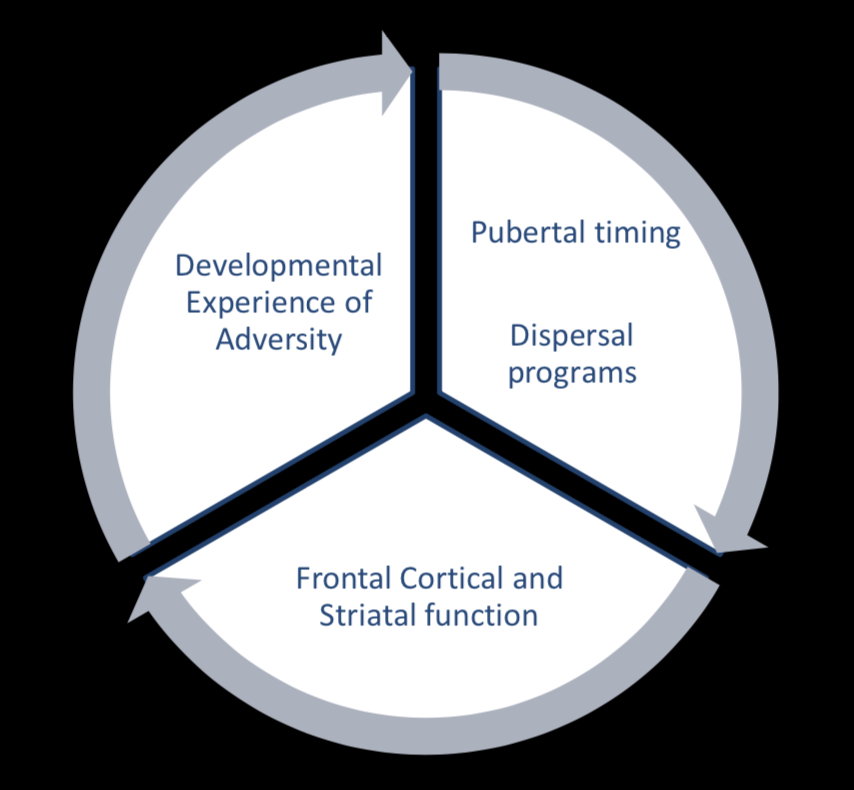
Research
Approaches
Recent Publications & Preprints
Hidden state inference requires abstract contextual representations in ventral hippocampus
The ability to form and utilize subjective, latent contextual representations to influence decision making is a crucial determinant of everyday life. The hippocampus is widely hypothesized to bind together otherwise abstract combinations of stimuli to represent such latent contexts, and to allow their use to support the process of hidden state inference. Yet, direct evidence for this remains limited. Here we show that the CA1 area of the ventral hippocampus is necessary for mice to perform hidden state inference during a 2-armed bandit task. vCA1 neurons robustly differentiate between the two abstract contexts required for this strategy in a manner similar to the differentiation of spatial locations, despite the contexts being formed only from past probabilistic outcomes. These findings offer [...]
Adolescent and adult mice use both incremental reinforcement learning and short term memory when learning concurrent stimulus-action associations
Computational modeling has revealed that human research participants use both rapid working memory (WM) and incremental reinforcement learning (RL) (RL+WM) to solve a simple instrumental learning task, relying on WM when the number of stimuli is small and supplementing with RL when the number of stimuli exceeds WM capacity. Inspired by this work, we examined which learning systems and strategies are used by adolescent and adult mice when they first acquire a conditional associative learning task. In a version of the human RL+WM task translated for rodents, mice were required to associate odor stimuli (from a set of 2 or 4 odors) with a left or right port to receive reward. Using logistic regression and computational models to analyze the [...]
Goal-directed learning in adolescence: neurocognitive development and contextual influences
Adolescence is a time during which we transition to independence, explore new activities and begin pursuit of major life goals. Goal-directed learning, in which we learn to perform actions that enable us to obtain desired outcomes, is central to many of these processes. Currently, our understanding of goal-directed learning in adolescence is itself in a state of transition, with the scientific community grappling with inconsistent results. When we examine metrics of goal-directed learning through the second decade of life, we find that many studies agree there are steady gains in performance in the teenage years, but others report that adolescent goal-directed learning is already adult-like, and some find adolescents can outperform adults. To explain the current variability in results, sophisticated [...]
The interpretation of computational model parameters depends on the context
Reinforcement Learning (RL) models have revolutionized the cognitive and brain sciences, promising to explain behavior from simple conditioning to complex problem solving, to shed light on developmental and individual differences, and to anchor cognitive processes in specific brain mechanisms. However, the RL literature increasingly reveals contradictory results, which might cast doubt on these claims. We hypothesized that many contradictions arise from two commonly-held assumptions about computational model parameters that are actually often invalid: That parameters generalize between contexts (e.g. tasks, models) and that they capture interpretable (i.e. unique, distinctive) neurocognitive processes. To test this, we asked 291 participants aged 8–30 years to complete three learning tasks in one experimental session, and fitted RL models to each. We found that some [...]
Lab News
Congratulations to Dr. Klinger!
Madeline Klinger submitted her thesis and earned a PhD from the Helen Wills Neuroscience Program (co supervised between Wilbrecht and Markita Landry lab). Congratulations Madeline!
Adolescence Across the Animal Kingdom
Our Center for the Developing Adolescent released a new podcast on animal adolescence here. We follow up with discussion here on the exciting insights into adolescence that we can learn from animals.
